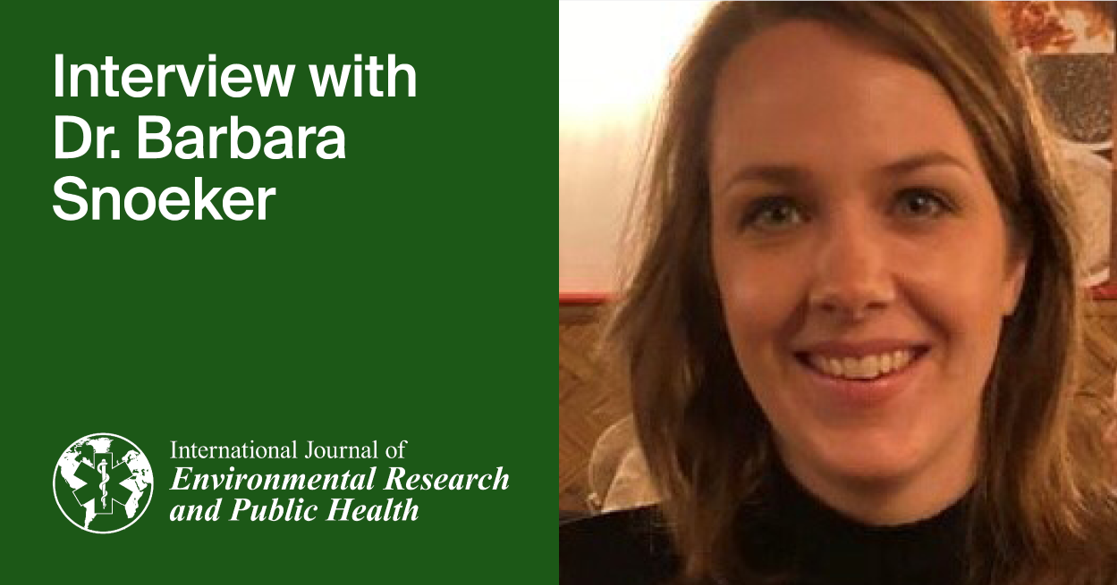
International Journal of Environmental Research and Public Health | An Interview with One of the Authors—Dr. Barbara Snoeker
Name: Dr. Barbara Snoeker
Affiliations: Center for Prevention, Lifestyle and Health, National Institute of Public Health and the Environment, 3721 MA Bilthoven, the Netherlands
Interests: physical activity, public health, epidemiology
“Physical Activity Friendliness of Neighborhoods: Do Subjective and Objective Measures Correspond Within a Mid-Sized Dutch Town?”
by Thomas G. Kuijpers, H. Susan J. Picavet, Jeroen Lakerveld, Johannes Mark Noordzij, G.C. Wanda Wendel-Vos and Barbara A. M. Snoeker
Int. J. Environ. Res. Public Health 2025, 22(4), 536; https://doi.org/10.3390/ijerph22040536
Available online: https://www.mdpi.com/1660-4601/22/4/536
The following is a short interview with Dr. Barbara Snoeker:
1. Could you briefly introduce yourself and your current research to our readers?
My name is Dr. Barbara Snoeker, and I work as a clinical epidemiologist and senior researcher at the National Institute for Public Health and the Environment in the Netherlands. I have always been passionate about the role of physical activity and its impact on health. My current research focuses on the role of physical activity and public health. At the Institute, I am the project leader of several projects. The purpose of our projects is to combine scientific research, policy, and practice, in order to inform evidence-based policymaking in the Netherlands. One key focus is monitoring physical activity behavior among the Dutch population, currently through questionnaires, while exploring the potential of accelerometers as a more accurate method of data collection. Additionally, I lead research on 24/7 physical activity behavior patterns to better understand how people distribute their movement throughout the day and week, and how that impacts their health. We are also developing a model to estimate the impact of physical activity policies on public health, quality of life, and associated costs. Finally, in our most recent study, we examined how objective and subjective measures of physical activity-friendly environments relate to physical activity levels, with new findings forthcoming that integrate accelerometer data to measure actual physical activity.
2. What difficulties or innovations did you encounter in your research?
One major challenge in our research relates to the mismatch between objective and subjective measures of physical activity-friendly environments. While a neighborhood might appear ideal on paper—green spaces, playgrounds, safe paths—the reality experienced by residents may differ significantly. For instance, access might be restricted, or people may not use the facilities that objectively classify an area as physical activity-friendly. This disconnect underscores the need to supplement objective data with subjective perspectives to understand how people engage with their environment. Without subjective input, policymakers may overlook critical barriers to physical activity.
On a broader level, a persistent challenge in the field is encouraging people to be more active in a world where inactivity is often easier. Policymakers must not only provide supportive infrastructure, but also ensure environments are truly conducive to healthy behavior.
3. What motivated you to conduct research in this field?
I have always been passionate about the role of physical activity in health. It’s a simple yet powerful way to prevent many non-communicable diseases and improve overall well-being. Despite its clear benefits, it’s often undervalued, especially since many of its advantages unfold over time.
My work is driven by the desire to contribute to a healthier society—not just in the Netherlands, but globally. Helping people to make sustainable health choices and informing policymakers with strong evidence are what keep me motivated.
4. How do you evaluate current research trends in your field, and what advice would you give to early career researchers starting their PhD?
Our recent study reinforces findings from earlier research—namely, that subjective and objective measures often diverge. So instead of chasing novelty, I believe the field needs to shift toward practical impact. We should ask: “How can environments be made healthier in ways that people experience?”, and future research should listen more closely to the communities we study. Understanding people’s motivations and barriers through qualitative research is crucial. Combining quantitative data with interviews or focus groups—what we call mixed-methods research—offers a richer, more actionable picture. For new researchers, I’d advise finding a topic that genuinely excites you. Identify your niche, connect with others in the field, and stay focused on the impact your work can make. Pursue a PhD not just for the title, but because you care deeply about the questions you’re exploring.
5. How did you hear about IJERPH, and what was your impression of the publication process?
The first author of our manuscript recommended IJERPH based on a previous positive experience. I found the process very smooth. The submission system was user-friendly, communication was fast, and even when the turnaround felt a bit rushed, we were able to request more time. Overall, it was a very positive experience, and I would be happy to publish with IJERPH again.